









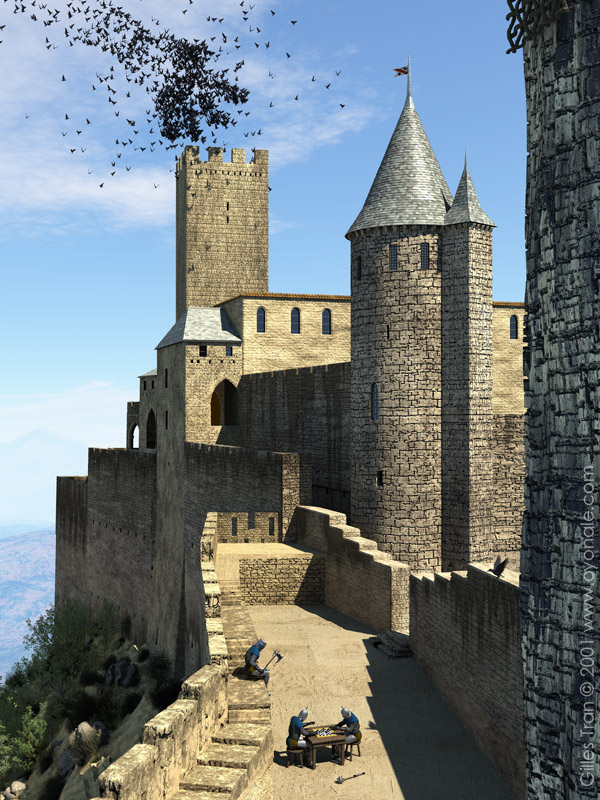
Artwork created in 2001
"Fortress": literal IRTC topics like one are an invitation to do the expected because more conceptual interpretations can quickly be received as off topic. It's not very inspirational, particularly if one doesn't care much for the subject. I hadn't planned to enter the competition, but as some of the work-in-progress was being shown in the Povray newsgroups, I got into one of those competitive moods and decided to run for it... and to play it as literal as possible. Since everyone else (but a few brave ones) would be busy building castles, I'd make one! And it would be as obvious as possible, a real postcard cliché that I would try to subvert a little. It was a bit of a challenge since I had never done an open-air, brightly lit, weathered construction. It meant radiosity, a lot of CSG, and many reference pictures. As it was already late (end of April 2001), I fished out the best pictures I had of Carcassonne, the oldest fortress in Europe, a place I had visited in 1986, and set out to work, without waiting for a true picture idea. I told myself that I would find one during the process.
The first step was to get the measurements right. The various heights, lengths and widths necessary to draw the plans and model the buildings were deduced from my own photographs of the place. After that, it was a matter of patience. Those interested by how the real place look like can have a look here and particularly at picture #15, which shows the same buildings from another point of view. A few evenings of boring CSG assembling based on boxes and cylinders gave me this:
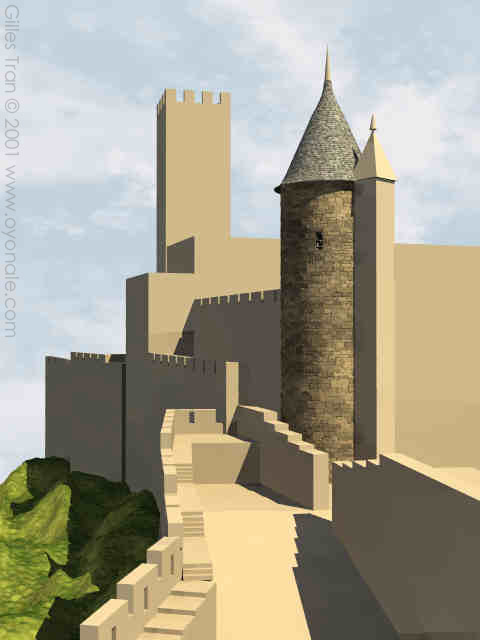
In the test above, the tower is made of individual bricks: I had first decided to build all the walls in that fashion, like I had done for "The prisoners". However, the close-ups didn't look right, so I eventually used other techniques. The main one was to paste on the boxes height fields generated by Povray (using a complex turbulent brick pattern). For the square tower and the buildings, the height fields were fed to a macro that folds them in two to create a smooth, rounded corner instead of a sharp one. For the two round towers, the height field image was used as a pigment to "displace" a cylindrical isosurface. To create the corresponding textures, the height fields were pasted on orthographic views of the walls and painted over. The dark streaks were obtained by layering a gradient pattern over the image map. I am not 100% satisfied with any of this, however.
The roofs of the towers were built using individual tiles (individually textured too). For the conic roof, the trick is to define the roof profile (by a function or a spline) and then to rotate the tiles around the y axis. It was a little more tricky for the square roofs. The shale roof on the left is just a triangle + polygon object textured with a variant of Jeff Lee's brick texture. Isosurfaces were used to make the crenels and the steps on the left (superellipsoids displaced with a turbulent brick pattern) and the window grids (mesh1 function).
I had a fortress, but what about the concept itself, the little bit of subversion I talked about previously? There would be soldiers, thanks to DAZ' Knight. They wouldn't pay attention to something big that would be going on.
But what sort of foe would they be facing? Certainly not enemy soldiers (too small). Not a dragon (too cliché). Not a giant, à la Gargantua/Pantagruel, as I didn't want to block the sky with it. A giant hand? It seemed a better idea: a hand was smaller, active, and immediately recognisable. So I amputated DAZ' Michael of one of his high-resolution hands, and had it push the tower. For the soldiers, having them playing chess was the most logical occupation, since the big hand in the sky was already playing the game. The chessboard from "The flood" was imported in the scene (with its real game in progress). I built a simple table and a pair of stools, and here they were, 3 innocent soldiers too absorbed in their virtual game to pay attention to reality. I considered adding some props, like shields, horses or barrels, but I finally I decided against it after a few tests. Version 6 looked like this:
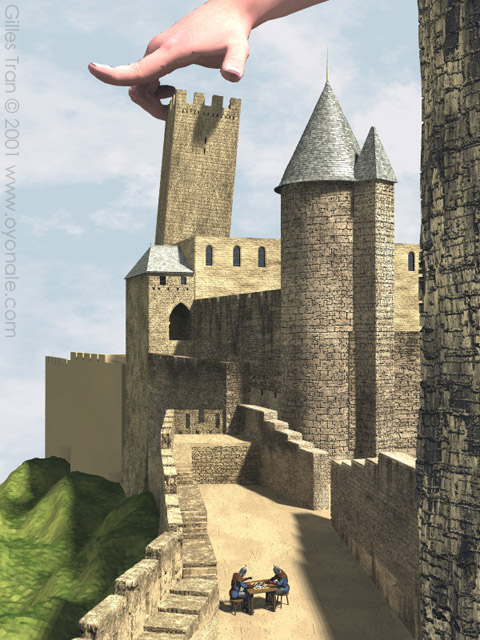
I had mixed feelings about the results. It certainly created the proper effect. However, I found this big pink object to be artistically disturbing. It ruined my postcard! In another, more conceptual picture, it would be all right, but here... I went on nevertheless, as many things remained to be done. I rendered an orthographic top view of the fortress and then used the resulting image as a guide to paint the rocky parts for a height field. This gave me the mountain ground on the left. I found some 3DS trees in my model directories and downloaded some grass patches from 3D Plants, a nice site with lots of free plant meshes. The trees and grass were scattered randomly using the trace function in two separate loops. A third loop planted rocks made of random isosurfaces.
Another remaining question was the sky and lighting. Until now, all the tests had been done with a slightly overcast sky, that gave a nice, painted feel to the image, thanks to radiosity. Too soft perhaps. I wanted something crisper. After all, it was supposed to be June, on Sunday, sometimes in the early afternoon. So I changed the colours, using a bright blue sky and a Terragen image in the background. I set up Terragen using the same colour and angle for the light as in the Povray scene. In fact, I could have done this with turbulent bozo clouds, some ground fog and a height field, but Terragen is so much simpler to use... It took several hours though, as testing and rendering large Terragen images is not so fast.
That left the hand problem. It was a disappointment. Not only it detracted from the rest of the picture, but close-ups clearly shown the shortcomings of this solution: high-resolution as it was, Michael's hand betrayed its CG origin with odd angles and bizarre shading. The texture map was lacking too. It looked like a big plaster or plastic hand, not a real one. I tested the skin shader available in Vahur Krouverk Povman patch. It simulates "reflection from layered surfaces due to subsurface scattering". A little bit overdone in this case, as can be seen in version 8 below:
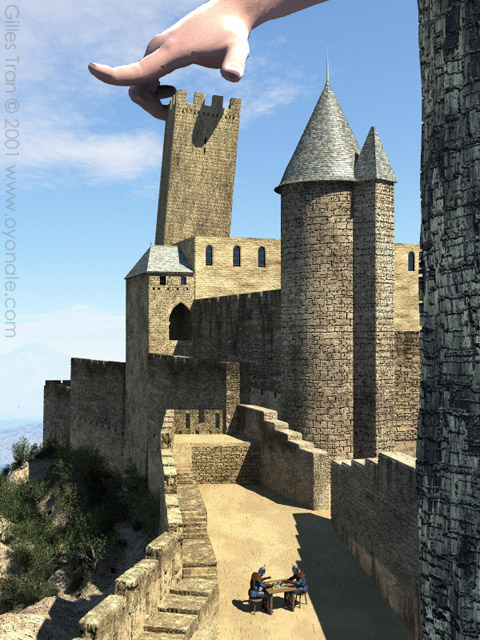
I tested many other ideas: brick textures, rock textures, metallic textures, media, X-Ray (thanks to Povman again). None fare much better. I started painting a larger, more detailed map for the hand, but this endeavour quickly proved itself beyond my technical and artistic abilities. I then converted the hand to the PCM format, using Warp's Meshcomp utility and the associated mesh macros by Chris Colefax. I extracted the vertices and normals of the hand mesh, and started putting things on the vertices. I tried different objects (rocks, bricks...) until I came up with the bird solution, more or less borrowed from Stephen King's novel "The Dark Half". I salvaged the 6 different ravens (original model by Sharkey) I had posed for "The scarecrow" and put 500 of them on the hand's vertices (actually on the vertex + normal axis), blurring the effect with randomness. Here it was: far from perfect, but more natural-looking that anything I had tried before in this image.
Finally, I added a raven to spy on the soldiers, and, to celebrate the victory on this troubled image, I hoisted a flag made with Clothray, the cloth-simulation feature created by Christophe Bouffartigue and included in Povman.
Version 13 below was a near-final version... until someone pointed out that the hand didn't look like a hand at all.
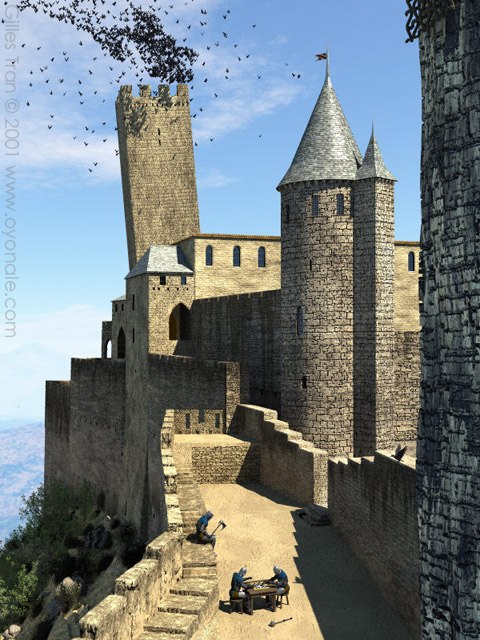
So I did a more hand-looking cloud (still far from successful) and straightened up the tower to downplay the situation.
The IRTC version took a day or so to render and a larger 2400 x 3200 version was rendered much later.
An animated tour of the image is here is available here (585 kb, 100 frames). It shows how artificial is the final setup, which was really made to look good only from one point of view.
Post September 11, 2001 comment: this image was created in April 2001, well before the events. Though it may be tempting to interpret the content of this image and some of its most troubling elements (the two towers, the tower being attacked by flying creatures guided by a human hand, the unsuspecting guards, the "enemy" bird already within the fortress), this is pure coincidence.